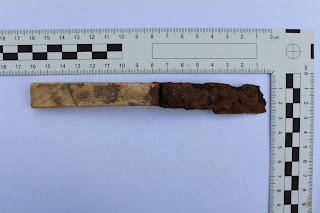Saturday 11 September 2021
Season's End
Fancy a tipple?
Tuesday 7 September 2021
Keep it buttoned
Special Find of the Day:
In 1774 a foul anchor surrounded by rope
edging took the place of a rose and in 1787 the same device, with the addition
of a wreath of laurel leaves, was adopted for Admirals. When the Merchant Navy
started to use the foul anchor device a crown was added for all naval officers
in 1812. The same basic design remains in use today.
The
foul anchor device itself was first recorded in use in the seal of the Lord
High Admiral of Scotland in 1402. It was subsequently adopted in the Admiralty
seal and by a large number of navies throughout the world. The rope 'fouling'
has no specific twist and may be deemed to be correct however it fits around
the anchor.
It is nice to think that someone from the navy visited Stalbridge House and then lost a button!
Monday 6 September 2021
Get stuck in
- Early 17th century - Forks became commonplace across Europe as a tool of steadying food while cutting, and in a lesser case for providing easier transfer of solid food between the plate and mouth. Majority of people still used sharply pointed knives for that purpose.
- 1630 - Forks and blunt tipped knives start arriving at colonies in North America.
- 1669 - French King Louis XIV of France banned the use of sharp tipped knives in France as a means of reducing violence. This introduced new era of blunt tipped eating knives.
AGM 2024
The DDCAG AGM took place and we discussed the forthcoming sites that we will be working on this year. The DMV in East Dorset was presented ...
-
Martin (left) and WDDAG WDDAG visited Martin Green's Down Farm this weekend, and what an experience it was! He took us through ...
-
This is a little film about how to distinguish between natural flint and human made tools. If you have found anything that you may think ...
-
Dorset Diggers Community Archaeology Group: Finding Flints : This is a little film about how to distinguish between natural flint and hum...





